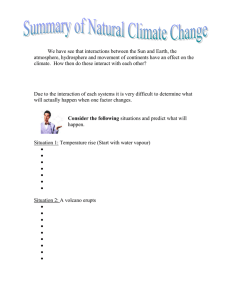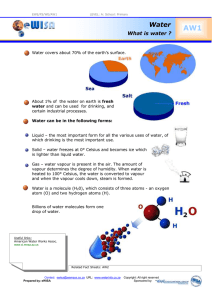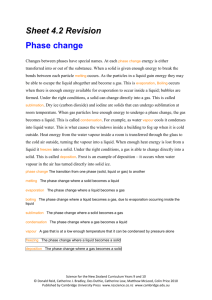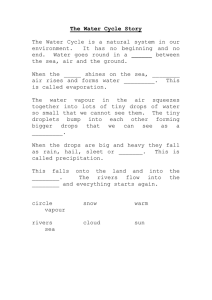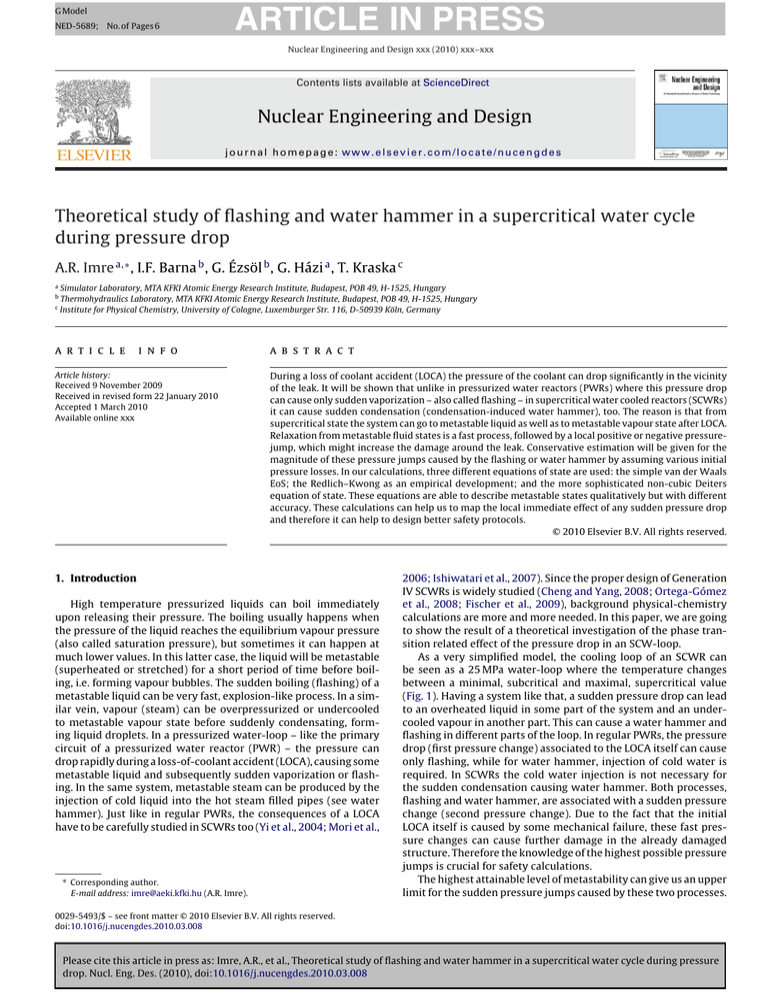
G Model
NED-5689;
No. of Pages 6
ARTICLE IN PRESS
Nuclear Engineering and Design xxx (2010) xxx–xxx
Contents lists available at ScienceDirect
Nuclear Engineering and Design
journal homepage: www.elsevier.com/locate/nucengdes
Theoretical study of flashing and water hammer in a supercritical water cycle
during pressure drop
A.R. Imre a,∗ , I.F. Barna b , G. Ézsöl b , G. Házi a , T. Kraska c
a
b
c
Simulator Laboratory, MTA KFKI Atomic Energy Research Institute, Budapest, POB 49, H-1525, Hungary
Thermohydraulics Laboratory, MTA KFKI Atomic Energy Research Institute, Budapest, POB 49, H-1525, Hungary
Institute for Physical Chemistry, University of Cologne, Luxemburger Str. 116, D-50939 Köln, Germany
a r t i c l e
i n f o
Article history:
Received 9 November 2009
Received in revised form 22 January 2010
Accepted 1 March 2010
Available online xxx
a b s t r a c t
During a loss of coolant accident (LOCA) the pressure of the coolant can drop significantly in the vicinity
of the leak. It will be shown that unlike in pressurized water reactors (PWRs) where this pressure drop
can cause only sudden vaporization – also called flashing – in supercritical water cooled reactors (SCWRs)
it can cause sudden condensation (condensation-induced water hammer), too. The reason is that from
supercritical state the system can go to metastable liquid as well as to metastable vapour state after LOCA.
Relaxation from metastable fluid states is a fast process, followed by a local positive or negative pressurejump, which might increase the damage around the leak. Conservative estimation will be given for the
magnitude of these pressure jumps caused by the flashing or water hammer by assuming various initial
pressure losses. In our calculations, three different equations of state are used: the simple van der Waals
EoS; the Redlich–Kwong as an empirical development; and the more sophisticated non-cubic Deiters
equation of state. These equations are able to describe metastable states qualitatively but with different
accuracy. These calculations can help us to map the local immediate effect of any sudden pressure drop
and therefore it can help to design better safety protocols.
© 2010 Elsevier B.V. All rights reserved.
1. Introduction
High temperature pressurized liquids can boil immediately
upon releasing their pressure. The boiling usually happens when
the pressure of the liquid reaches the equilibrium vapour pressure
(also called saturation pressure), but sometimes it can happen at
much lower values. In this latter case, the liquid will be metastable
(superheated or stretched) for a short period of time before boiling, i.e. forming vapour bubbles. The sudden boiling (flashing) of a
metastable liquid can be very fast, explosion-like process. In a similar vein, vapour (steam) can be overpressurized or undercooled
to metastable vapour state before suddenly condensating, forming liquid droplets. In a pressurized water-loop – like the primary
circuit of a pressurized water reactor (PWR) – the pressure can
drop rapidly during a loss-of-coolant accident (LOCA), causing some
metastable liquid and subsequently sudden vaporization or flashing. In the same system, metastable steam can be produced by the
injection of cold liquid into the hot steam filled pipes (see water
hammer). Just like in regular PWRs, the consequences of a LOCA
have to be carefully studied in SCWRs too (Yi et al., 2004; Mori et al.,
∗ Corresponding author.
E-mail address: imre@aeki.kfki.hu (A.R. Imre).
2006; Ishiwatari et al., 2007). Since the proper design of Generation
IV SCWRs is widely studied (Cheng and Yang, 2008; Ortega-Gómez
et al., 2008; Fischer et al., 2009), background physical-chemistry
calculations are more and more needed. In this paper, we are going
to show the result of a theoretical investigation of the phase transition related effect of the pressure drop in an SCW-loop.
As a very simplified model, the cooling loop of an SCWR can
be seen as a 25 MPa water-loop where the temperature changes
between a minimal, subcritical and maximal, supercritical value
(Fig. 1). Having a system like that, a sudden pressure drop can lead
to an overheated liquid in some part of the system and an undercooled vapour in another part. This can cause a water hammer and
flashing in different parts of the loop. In regular PWRs, the pressure
drop (first pressure change) associated to the LOCA itself can cause
only flashing, while for water hammer, injection of cold water is
required. In SCWRs the cold water injection is not necessary for
the sudden condensation causing water hammer. Both processes,
flashing and water hammer, are associated with a sudden pressure
change (second pressure change). Due to the fact that the initial
LOCA itself is caused by some mechanical failure, these fast pressure changes can cause further damage in the already damaged
structure. Therefore the knowledge of the highest possible pressure
jumps is crucial for safety calculations.
The highest attainable level of metastability can give us an upper
limit for the sudden pressure jumps caused by these two processes.
0029-5493/$ – see front matter © 2010 Elsevier B.V. All rights reserved.
doi:10.1016/j.nucengdes.2010.03.008
Please cite this article in press as: Imre, A.R., et al., Theoretical study of flashing and water hammer in a supercritical water cycle during pressure
drop. Nucl. Eng. Des. (2010), doi:10.1016/j.nucengdes.2010.03.008
G Model
NED-5689;
No. of Pages 6
2
ARTICLE IN PRESS
A.R. Imre et al. / Nuclear Engineering and Design xxx (2010) xxx–xxx
Nomenclature
LOCA
SCWR
EoS
PWR
SCW
vdW
RK
D
IAPWS
loss of coolant accident
supercritical water cooled reactor
equation of state
pressurized water reactor
supercritical water
van der Waals
Redlich–Kwong
Deiters
International Association for the Properties of Water
and Steam
This level depends on a number of variables, including the purity of
the liquid, the speed of the pressure or temperature change, etc. As
a final limit, one can use the so-called mean-field spinodal, which is
the thermodynamic stability limit where the isothermal compressibility of the system would turn into negative, causing instability
(Debenedetti, 1996; Imre et al., 2002). These stability limits cannot
be reached in liquid–vapour systems but they can be approached
by changing the pressure/temperature very rapidly in a pure liquid
or steam. Strictly speaking the spinodal is rather a diffusive stripe
than a discrete curve as suggested by the so-called mean-field spinodal. However, the mean-field spinodal can be treated as very final
limit of metastability.
The vapour spinodal is the limit where the vapour immediately
has to turn into liquid. The liquid spinodal is the limit where the liquid has to boil immediately. Both can be easily calculated from an
accurate equation of state (EoS) (Kraska, 2004; Abbasi and Abbasi,
2007; Jancskar and Iványi, 2008). Unfortunately, most EoS cannot be used in the metastable region; this is particularly true for
most of the reference EoSs, which are tuned only to describe stable liquid and vapour states and can produce several unphysical
maxima, minima and divergences on the isotherms. For water, the
so-called IAPWS (also called Wagner) EoS can be used to describe
stable steam and liquid phases (Wagner and Pruss, 2002) but it cannot be used in the metastable region. Therefore we will use three
other equations, which are less accurate but can be applied in the
metastable region, too. By using these EoSs, we will give some estimation for the pressure jumps caused by the sudden vaporization or
sudden condensation following a LOCA in a SCW-loop (SCW LOCA).
Fig. 1. A simplified, but topologically correct model of the cooling loop of an SCWR.
The arrow marks the direction of the circulation.
and vice versa. In addition, it is known that the calculated spinodal
is typically behind the experimentally obtained attainable stability limit for certain equations of state, which is consistent (Kraska,
2004).
Concerning the second assumption, the actual path for the initial
pressure drop and temperature change (Fig. 2) to reach the stability
line does not influence the final result (see later). Concerning the
pressure jumps during phase transition (this is the second pressure
change), due to the high speed, it is also accepted to approximate
them with an isothermal path. Fast processes considered here are
usually handled as adiabatic, not isotherm. In the liquid phase, the
two paths are not very much different (adiabatic paths in the stud-
2. Models
2.1. Equation of states and spinodals
In our calculations, we used some assumptions to simplify the
problem. The main assumption is that we are going to accept the
validity of the EoS in the metastable region and we also accept
that the equation, which can give us better results in the stable
region, is probably also better in the metastable region. The second
assumption is a simplification, namely instead of adiabatic changes,
isotherm–isobar paths have been used. The third assumption is that
we expect that the pressurized or stretched water jumps back only
to the equilibrium value upon relaxing. For our calculations, the
ThermoC code has been used (Deiters, 2006).
Concerning the first assumption, it is known that very sophisticated reference equation of states are completely inappropriate in
the metastable region, giving several false stability limits, but – at
least theoretically – the cubic equation of states and a few non-cubic
ones can be used there. The second part of the first assumption is
difficult to check, but at least one can assume that when an EoS gives
worse result for the critical point (which is the final point of the
spinodal lines) than probably the whole spinodal line will be worse
Fig. 2. Two different pT-paths starting from the same initial condition to reach the
same point of the stability line (path 1 is a complex path, path 2 is a simplified
isobar–isotherm one). The final pressure-jump (solid arrow) does not depend on
the path.
Please cite this article in press as: Imre, A.R., et al., Theoretical study of flashing and water hammer in a supercritical water cycle during pressure
drop. Nucl. Eng. Des. (2010), doi:10.1016/j.nucengdes.2010.03.008
G Model
NED-5689;
No. of Pages 6
ARTICLE IN PRESS
A.R. Imre et al. / Nuclear Engineering and Design xxx (2010) xxx–xxx
3
Fig. 3. Vapour pressure curves for water, calculated with various equation of states
(vdW: van der Waals, RK: Redlich–Kwong, IAPWS: Wagner–Pruss, and D: Deiters).
ied conditions would be associated with a 1–2 K shifts), but in the
vapour phase isothermal and adiabatic paths are quite different.
In our studies, isothermal paths were considered for two reasons.
First, experimental results suggest (see, for example, Barten et al.,
2008) that the pressure and temperature changes associated with
LOCA is neither isothermal, nor adiabatic, but still much closer to
an isotherm. RELAP5 calculations suggested approx. 100 K temperature increase (using adiabatic model), while the measured change
was only 5–8 K.
The third assumption of incompressible liquid water is not really
good but we can use it to get some conservative estimate.
The three EoSs used in our calculations are the classical van
der Waals (vdW) equation of state (van der Waals, 1910), the
Redlich–Kwong (RK) equation of state (Redlich and Kwong, 1949)
and the Deiters (D) equation of state (Deiters, 1981a,b, 1983). The
vdW-EoS is the oldest cubic equation of state, quite inaccurate and
mainly historically and topologically interesting. The RK-EoS is an
empirical extension of the vdW-EoS used mainly at higher temperatures, but not yet very good for water. The D-EoS is non-cubic
and exhibits quite fair result for water. To check the accuracy of
these EoSs, we are calculating the vapour pressure and compare it
to the value given by the IAPWS-95 reference equation. The results,
calculated by the ThermoC program (Deiters, 2006), using the builtin parameters for water, can be seen in Fig. 3. The vapour pressure
curve given by the van der Waals equation differs from the IAPWS to
a great extent, the D-EoS predicts the vapour pressure curve fairly
well, while the difference by the RK-EoS – just as we expected –
is between the two others. As an example, we show the vapour
pressures at 500 K: for the IAPWS reference EoS it is 2.63 MPa, for
the vdW EoS it is 7.19 MPa (+4.56 MPa difference), for the RK EoS
it is 4.21 MPa (1.58 MPa difference), and finally for the D-EoS it is
1.71 MPa (0.92 MPa difference).
In Fig. 4 the fluid–fluid phase- and stability diagram is shown
in the vicinity of the critical point calculated by the three different
EoSs. Solid lines mark the vapour pressure curves; dashed curves
mark the liquid–vapour spinodal where the metastable liquid must
turn into vapour; the dotted curves mark the vapour–liquid spinodal where the metastable vapour must turn into liquid; the grey
dot-dash is the so-called Widom-line or pseudospinodal (Stanley
et al., 2008), which is a diffuse border between the liquid-like SCW
and the vapour-like SCW; and finally the upper short-dashed curves
mark the normal working condition of the water in an SCWR. The
vapour pressure curve, the two spinodals and the Widom-line meet
in the critical point. The Widom-line is the line where the compressibility of the SCW has a maximum. The region around the
Widom-line is the zone, where most properties of the SCW change
Fig. 4. Vapour pressure curves (solid), liquid–vapour spinodals (dashed),
vapour–liquid spinodals (dotted), and pseudospinodals (grey dot-dashed) for water,
calculated with van der Waals (a), Redlich–Kwong (b) and Deiters (c) equation of
states. Short-dashed lines mark the normal working condition of the water in an
SCWR.
rapidly. At temperatures below the Widom-line the SCW is more
liquid-like, where at temperatures above it the SCW is more like a
vapour, concerning several relevant chemical and physical properties.
3. LOCA in an SCWR loop
We use here an unstructured water-loop (i.e. a ring-formed
closed pipe without pressurizer) as model, where the initial pressure is 25 MPa and the temperature at one part 551 K, changing
smoothly to 769 K at the opposite side of the circle (Fig. 1). When
pipe breaks, we assume an immediate pressure loss at the vicinity of
the breaking point. We calculate two cases, locating the breaks into
the two temperature extrema. The pressure loss will spread along
Please cite this article in press as: Imre, A.R., et al., Theoretical study of flashing and water hammer in a supercritical water cycle during pressure
drop. Nucl. Eng. Des. (2010), doi:10.1016/j.nucengdes.2010.03.008
G Model
NED-5689;
4
No. of Pages 6
ARTICLE IN PRESS
A.R. Imre et al. / Nuclear Engineering and Design xxx (2010) xxx–xxx
Fig. 6. The effect of a 5 MPa pressure drop on the high-temperature side of a SCWloop, (b) is the magnification of (a). Further description can be seen in Fig. 5 and in
the text.
Fig. 5. The effect of a 5 MPa pressure drop in the low-temperature side of a SCWloop, figure (b) is the magnification of figure (a). Short-dashed line mark the normal
working condition of the water in an SCWR, grey square marks the initial condition
of the LOCA, dashed lines are the spinodals, solid line is the vapour pressure curve.
Dotted line marks the isotherm pressure drop, the isobaric heating of the water and
finally the sudden pressure-jump caused by the vaporization. Full description can
be seen in the text.
the loop. In Fig. 5 one can see the effect of a pressure drop caused
by a LOCA in the region where the SCW is more liquid-like (i.e.
at lower temperatures, below TWidom (25 MPa) ≈ 658 K ≈ 385 ◦ C). In
Fig. 6, the same process can be seen on the high-temperature side.
In both figures, part (b) is a magnification of the region of sudden
boiling or condensation.
The whole process is demonstrated in Figs. 5 and 6. In Fig. 5,
one can see a sudden pressure drop from 25 to 20 MPa (down-side
dotted arrow, starting from the initial condition, marked by grey
square). A 5 MPa pressure drop resembles to a small or medium
break LOCA in PWR, but because the density and compressibility of
supercritical water are much smaller than for the subcritical water,
a geometrically identical leak can cause smaller and/or slower pressure drop in SCWR loops. Therefore, 5 MPa might be caused by
a medium or large break SCWR-LOCA too. This drop happens in
the low-temperature part of the SCW-loop, but then – due to the
permanent loss of pressurized fluid – this “low-pressure” zone
will expand into the higher temperature region (vertical dotted
arrows). It should be noted that the arrows are a simplified path
while the real path is not linear, i.e. not isothermal nor isobaric.
On the other hand, the path from the initial condition to point B
does not influence the magnitude of the B-to-C jump, therefore it is
irrelevant. Crossing the vapour pressure line (point A) the already
liquid water will be metastable (superheated). In the vicinity of
the liquid–vapour spinodal (point B) the extremely high level of
metastability has to cause sudden boiling, causing pressure-jump
(upward dotted arrow). After a transient pressure peak – neglected
in our model – the system will be more or less equilibrated at the
vapour pressure (point C).
In Fig. 6, one can see a similar pressure drop (long downward
dotted arrow), happening in the high-temperature region. The lowpressure zone will expand into the direction of low-temperature
region. Crossing the vapour pressure line (point A) the already
vaporized water will be metastable steam. In the vicinity of the
vapour–liquid spinodal (point B) it has to condensate, causing a
pressure drop (short downward arrow). After the neglected transient pressure peak, the system will be more or less equilibrated at
the vapour pressure (point C).
In Fig. 7, one can see the absolute value of the pressure differences before and after the sudden vaporization or condensation
(abs(p(C)-p(B)), following various initial pressure drop (starting
from 25 MPa), calculated by the vdW-, RK- and D-EoS. The solid
lines are associated with the sudden vaporization, the dashed ones
are associated with the sudden condensation. As one can see, the
pressure-jump associated with the sudden phase transitions are as
big as several MPa. Thus surely enough can cause some problems for
the already damaged pipe walls. Jumps calculated by the D-EoS are
approximately 50% higher than by the ones calculated by the vdWEoS; this can demonstrate the necessity to use a more accurate EoS.
For initial pressure drops below approx. 3 MPa (which is equal with
the difference of the working and critical pressures), sudden con-
Please cite this article in press as: Imre, A.R., et al., Theoretical study of flashing and water hammer in a supercritical water cycle during pressure
drop. Nucl. Eng. Des. (2010), doi:10.1016/j.nucengdes.2010.03.008
G Model
NED-5689;
No. of Pages 6
ARTICLE IN PRESS
A.R. Imre et al. / Nuclear Engineering and Design xxx (2010) xxx–xxx
5
Sudden condensation is only a necessary but not sufficient condition for water hammer. In subcritical water + steam systems there
are various thermal, hydraulic, geometrical, etc. conditions which
have to be fulfilled to obtain water hammer. These conditions are
the following (Griffith, 1997):
a.
b.
c.
d.
e.
f.
Fig. 7. The absolute magnitude of the sudden pressure change (abs(p(C)–p(B)), associated with sudden boiling or condensation following SCW LOCA, calculated by van
der Waals and by Deiters equation of states.
densation cannot be seen, because the water still remains above the
critical pressure and the temperature change itself cannot induce
phase transition. We should remark here that in our previous report
(Imre et al., 2009b), the pressure jumps associated to the sudden
condensation were underestimated; the correct values are reported
here.
We should mention here, that any deviation from the isothermicity to the direction of adiabacity (Barten et al., 2008) would
shift point C (Fig. 6/b) higher on the vapour pressure curve, causing
smaller p(B)–p(C) jump. Therefore isotherm path still can be used
to find upper limit for the jump.
One can see that for initial pressure drops smaller than approx.
3 MPa, nothing happens. This is due to the lack of phase transition
above the critical point. In this vein, we could propose that for SCWloops, where the normal working pressure are higher, one can have
a safety pressure drop range where both phenomena can be avoided
and which can be increased by increasing the working pressure
(in case of 30 MPa working pressure it would be an 8 MPa range).
Therefore the increase of the working pressure would be a possible
way to avoid LOCA-related phase transitions in SCWRs.
Another way to avoid sudden boiling or condensation would be
the prevention of the extension of the low pressure zone. In Fig. 8,
one can see that by stopping the “negative” pressure wave before
reaching the vapour pressure curve (at point A, before reaching
point B) by properly inserting one or more pressurizer, one could
avoid the phase transition.
the pipe most be almost horizontal;
the subcooling must be greater than 20 ◦ C;
the length/diameter must be above 24;
the velocity must be low enough;
there should be a void nearby;
the pressure must be high enough so that significant damage
occurs.
From these conditions, only point “b” and “e” is necessary to
obtain sudden condensation, the other four are needed to turn this
condensation to damaging water hammer. For SCW-loops, a similar
set of conditions will be necessary to obtain a water hammer; some
of them might be similar but some of them will be certainly different. The extent of necessary subcooling to obtain metastability and
sudden condensation is temperature-dependent (Imre et al., 2002;
Imre et al., 2008; Kraska, 2004), close to the critical point the whole
metastable region can be narrower than 20 ◦ C, therefore for SCWRs
(where the temperatures are much higher than for PWRs) point
“b” probably should be modified. Point “e” declares the presence
of a vapour void; in SCWR loops, this will not be necessary, being
the whole system “vapour-like”. To find the necessary conditions
to obtain a water hammer in an SCW-loop, further and detailed
studies will be needed; some of them are already in progress.
4. Summary
We have analyzed the aftermath of a sudden pressure loss (e.g.
LOCA) in a simplified SCW-loop. Depending on the location of the
pressure loss (leak), the initial pressure drop can cause sudden
boiling (flashing) or sudden condensation (water hammer). Using
three different equation of states (van der Waals, Redlich–Kwong
and Deiters) we calculated the pressure change caused by the
phase transition as the function of the initial pressure drop. Using
the same assumptions, an initial 10 MPa pressure drop caused a
secondary pressure drop/jump during water hammer or flashing:
approx. 2.1 MPa with vdW-EoS, 2.6 MPa with RK-Eos and finally
approx. 3.1 MPa by D-Eos. The differences demonstrate the necessity to find a good EoS or any other method to calculate spinodals
(Imre et al., 2008; Imre and Kraska, 2008; Imre et al., 2009). Finally,
we tried to indicate how to avoid the phase transition, which can
cause further damage in the already damaged pipes.
Acknowledgements
This work was supported by National Office for Research and
Technology under the grant NUKENERG2. A.R. Imre was supported
by Hungarian Research Fund (OTKA) under contract No. K67930
and the German Humboldt Foundation. The authors wish to thank
the helpful advise of Prof. I. Tiselj (Slovenia).
References
Fig. 8. A possible pressure-temperature route to avoid phase transition following
SCW LOCA.
Abbasi, T., Abbasi, S.A., 2007. Accidental risk of superheated liquids and a framework for predicting the superheat limit. Journal of Loss Prevention in the Process
Industries 20, 165–181.
Barten, W., Jasiulevicius, A., Manera, A., Macian-Juan, R., Zerkak, O., 2008. Analysis
of the capability of system codes to model cavitation water hammers: simulation of UMSICHT water hammer experiments with TRACE and RELAP5, Nuclear
Engineering and Design, 1129–1145.
Cheng, X., Yang, Y.H., 2008. A point-hydraulics model for flow stability analysis.
Nuclear Engineering and Design 238, 188–199.
Please cite this article in press as: Imre, A.R., et al., Theoretical study of flashing and water hammer in a supercritical water cycle during pressure
drop. Nucl. Eng. Des. (2010), doi:10.1016/j.nucengdes.2010.03.008
G Model
NED-5689;
6
No. of Pages 6
ARTICLE IN PRESS
A.R. Imre et al. / Nuclear Engineering and Design xxx (2010) xxx–xxx
Debenedetti, P.G., 1996. Metastable Liquids: Fundamentals and Applications. Princeton University Press.
Deiters, U.K., 1981a. A new semiempirical equation of state for fluids. I. Derivation.
Chemical and Engineering Science 36, 1139–1146.
Deiters, U.K., 1981b. A new semiempirical equation of state for fluids. II. Application
to pure substances. Chemical and Engineering Science 36, 1146–1151.
Deiters, U.K., 1983. Calculation and prediction of fluid phase equilibria from an
equation of state. Fluid Phase Equilibria 10, 173–182.
Deiters, U.K., 2006, ThermoC, http://thermoc.uni-koeln.de/index.html.
Fischer, K., Schulenberg, T., Laurien, E., 2009. Design of a supercritical water-cooled
reactor with a three-pass core arrangement. Nuclear Engineering and Design
239, 800–812.
Griffith, P., 1997, Screening Reactor Steam/Water Piping systems for Water Hammer,
NUREG/CR-6519.
Imre, A.R., Maris, H.J., Williams, P.R. (Eds.), 2002. Liquids Under Negative Pressure,
NATO Science Series. Kluwer, Dordrecht.
Imre, A.R., Mayer, G., Házi, G., Rozas, R., Kraska, T., 2008. Estimation of the
liquid–vapor spinodal from interfacial properties obtained from molecular
dynamics and lattice Boltzmann simulations. Journal of Chemical Physics 128,
114708.
Imre, A.R., Kraska, T., 2008. Liquid–vapour spinodal of pure helium-4. Physica B 403,
3663–3666.
Imre, A.R., Házi, G., Kraska, T., 2009a. Estimation of the explosive boiling limit of
metastable liquids. In: Rzoska, S.J., Mazur, V.A. (Eds.), NATO Science Series:
Metastable Systems Under Pressure: Platform for New Technologies and Environmental Applications. Springer, pp. 271–278.
Imre, A.R., Barna, I.F., Farkas, I., Márkus, A., Házi, G., Kraska, T., 2009b. Theoretical
investigation of sudden vaporization and water hammer in SCWR during Loss
of Coolant Accidents. In: Proceeding of the 4th International Symposium on
Supercritical Water-Cooled Reactors, Paper No. 14.(CD).
Ishiwatari, Y., Oka, Y., Koshizuka, S., 2007. Safety of the super LWR. Nuclear Engineering and Technology 39, 257–272.
Jancskar, I., Iványi, A., 2008. Phenomenological hysteresis model for vapor–liquid
phase transitions. Pollack Periodica 3, 5–28.
Kraska, T., 2004. Stability limit of pure substances: an investigation based on equation of state. Industrial & Engineering Chemistry 43, 6213–6221.
Mori, M., Maschek, W., Rineiski, A., 2006. Heterogeneous cores for improved safety
performance: A case study: the supercritical water fast reactor. Nuclear Engineering and Design 236, 1573–1579.
Ortega-Gómez, T., Class, A., Lahey Jr., R.T., Schulenberg, T., 2008. Stability analysis of
a uniformly heated channel with supercritical water. Nuclear Engineering and
Design 238, 1930–1939.
Redlich, O., Kwong, J.N.S., 1949. On the thermodynamics of solutions. V. An equation
of state. Fugacities of gaseous solutions. Chemical Reviews 44, 233–244.
Stanley, H.E., Kumar, P., Franzese, G., Xu, L., Yan, Z., Mazza, M.G., Buldyrev, S.V.,
Chen, S.H., Mallamace, F., 2008. Liquid polyamorphism: possible relation to the
anomalous behaviour of water. European Physical Journal 161, 1–17.
van der Waals, J.D., 1910, The Equation of State for Gases and Liquids, Nobel Lecture,
http://nobelprize.org/nobel prizes/physics/laureates/1910/waals-lecture.pdf
(12.12.1910).
Wagner, W., Pruss, A., 2002. The IAPWS formulation 1995 for the thermodynamic
properties of ordinary water substance for general and scientific use. Journal of
Physical and Chemical Reference Data 31, 387–535.
Yi, T.T., Ishiwatari, Y., Koshizuka, S., Oka, Y., 2004. Startup thermal analysis of a
high-temperature supercritical-pressure light water reactor. Journal of Nuclear
Science and Technology 41, 790–801.
Please cite this article in press as: Imre, A.R., et al., Theoretical study of flashing and water hammer in a supercritical water cycle during pressure
drop. Nucl. Eng. Des. (2010), doi:10.1016/j.nucengdes.2010.03.008

